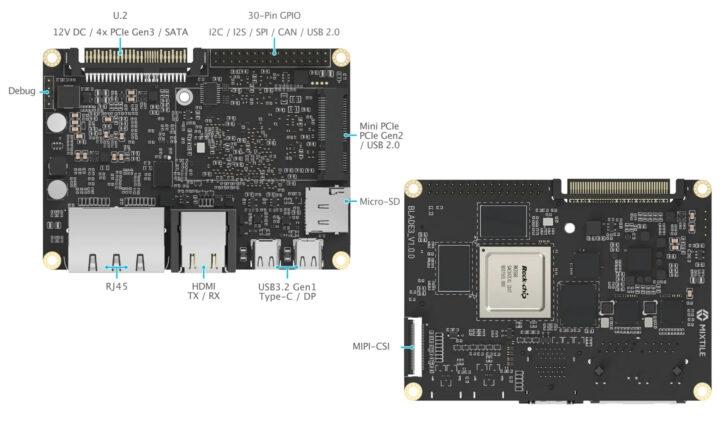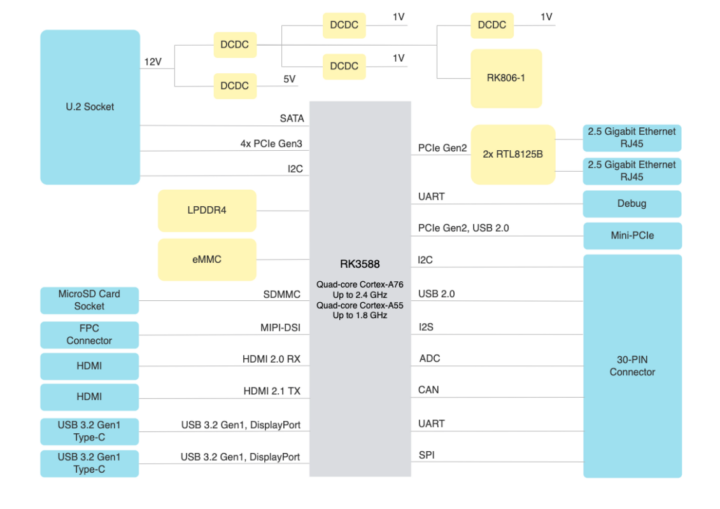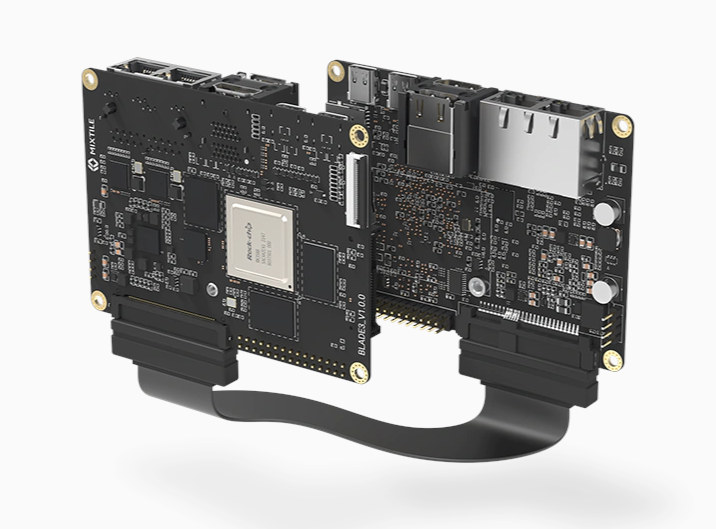The Rockchip RK3588 hype continues with the Mixtile Blade 3, a new Pico-ITX board powered by the Cortex A76/A55 processor, coupled with up to 32GB RAM, up to 256GB storage, and designed for server applications with two 2.5GbE interfaces.
The single board computer also comes with HDMI 2.1 output, HDMI 2.0 input, USB 3.2 Gen 1 USB Type-C ports, a mini PCIe Gen 2 for expansion, and a PCIe Gen 3 x4 connector to connect two Mixtile Blade 3 boards together for high-performance computing.
Mixtile Blade 3 specifications:
- SoC – Rockchip RK3588 octa-core processor with four Arm Cortex-A76 cores @ up to 2.4 GHz, four Arm Cortex-A55 cores, ArmMali-G610 MP4 quad-core GPU with support for OpenGL ES3.2, OpenCL 2.2, Vulkan1.1, 6 TOPS NPU, 48MP ISP, 8Kp60 video decoding, 8Kp30 video encoding
- System Memory – Up to 32GB LPDDR4 memory
- Storage – Up to 256GB eMMC flash, MicroSD 3.0 card socket, SATA 3.0 via U.2 edge connector,
- Video interfaces
- HDMI 2.1 out 8Kp60
- HDMI 2.0 in 4Kp60
- 4-lane MIPI DSI
- DisplayPort 1.4a via USB-C ports
- Networking – Dual 2.5 Gigabit Ethernet RJ45 ports with link aggregation
- USB – 2x USB 3.2 Gen1 Type-C ports with DisplayPort 1.4a
- Expansion
- U.2 edge connector with 4-lane PCIe Gen3, SATA 3.0
- Mini PCIe socket with PCIe Gen2.1 and USB 2.0
- 30-pin GPIO header with GPIOs, I2C, USB 2.0, TTL UART, SPI, I2S, ADC
- Power Supply – 12V via U.2 connector
- Dimensions – 100 x 72 mm (2.5-inch Pico-ITX form factor)
- Temperature Range – 0 to +80°C
The company plans to provide Android 12 with a Linux container, and although the board is quite versatile, when asked whether the board was designed for server applications, Mixtile confirmed it indeed was. When further asked why not just run Linux, I was told that driver support for Android 12 is better, so they just run a Linux container inside Android to make software development easier…
Some of the use cases include simple clusters and high-density servers with up to 75 Blade 3 boards in a standard 2U 19-inch chassis that would get 600 cores and the equivalent of 630 GHz of computing power in 1500 watts power envelop.
Pricing is quite competitive, especially considering Firefly is asking for close to $500 for their RK3588 mini-ITX motherboard, with Mixtile Blade 3 selling for $160 with 4GB RAM and 32GB storage, $195 in 8GB/64GB configuration, and $259 in 16GB/128GB configuration. Those are still pre-order, but the Mixtile shop reads “preorders will end by March 31 and ship in April.” That looks like an optimistic schedule to me, and when I asked for photos of the board, I was told that the real samples are not available yet, they’ve completed the schematics, and are currently working on the PCB layout. I had a good laugh, and I can tell you the board is almost certainly not shipping in April! Having said that, it’s most probably not vaporware, as Mixtile has been around for several years, and we wrote about their boards as far back as 2014.

Jean-Luc started CNX Software in 2010 as a part-time endeavor, before quitting his job as a software engineering manager, and starting to write daily news, and reviews full time later in 2011.
Support CNX Software! Donate via cryptocurrencies, become a Patron on Patreon, or purchase goods on Amazon or Aliexpress







